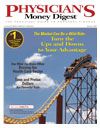Publication
Article
Physician's Money Digest
Who Is Nat Fein and What Can He Teach Us?
Author(s):
New York-Herald Tribune
One of the most famous photos in sports historywas taken by Nat Fein, who was not asports photographer. Fein worked for theand spent a lot of timetrolling around the Big Apple for pictures of dogs,children, and any oddities that attracted his interest.But on June 13, 1948, Fein made both newspaperand sports history.
He was ordered to Yankee Stadium to take whatevershots he could of the 25th anniversary of theHouse That Ruth Built because the other guy calledin sick. The high note of that day was the retirementof Babe Ruth's number-three pinstriped uniform. TheSultan of Swat was age 53 and slowly dying of whatwas later announced to be cancer.
Seize a Different Perspective
Barely able to walk, the Babe was the object ofhundreds of professional cameras, thus creating quitea crowd of which Fein wanted no part. They occupiedboth the first and third baselines to get a candidof Ruth's widely-known face. Meanwhile, Fein gotclose up, right behind the Bambino, to get a pictureof that famous number three.
According to some fans, Fein captured the mostfamous image in American sports history, "The BabeBows Out," and won a Pulitzer Prize for his efforts.To get that shocking photo of a hunched figure thatcould barely stand, Nat Fein had to see things differently.He had to take a different approach.
Translation:
Warren Buffett said it best in his 2004 letter toBerkshire-Hathaway shareholders, "Investors shouldremember that excitement and expenses are theirenemies. And if they insist on trying to time theirparticipation in equities, they should try to be fearfulwhen others are greedy and greedy only whenothers are fearful." If you want to makeabove-average profits with below-average risk, don'tdo what everyone else is doing. Instead, take a differentapproach.
Resist the Fear Factor
Right now, there is more than enough fear to goaround, much like late 2002 and early 2003. Some ofthe big fear factors of that time period included: theshock-and-awe invasion of Iraq, the predictions ofterrorist attacks similar to or worse than Sept. 11,mutual fund scandals, Enron, North Korea, theSARS virus with numerous forecasts of a worldwidepandemic, the Israel-Palestine conflict, war inAfghanistan, global deflation, rising unemployment,the threat of a prolonged domestic recession, andmany other serious fears floating hither and yon.
Yet in looking back, 2003 was the finest year forstocks in the past quarter century. And guess what?Most investors, alongside a lot of professionals,missed it. Why? Because they did what almost everyoneelse was doing. They ran scared and placed muchof their funds available for investing in money markets,CDs, bonds, and other fixed income. This issimilar to what is going on right now.
Today we're at a crossroads similar to 4 years ago.And just like 4 years ago, if you do what everyoneelse is doing, you're going to be left at the startinggate when stocks take off. Don't be left behind.
Bill Staton, MBA, CFA, is chairman of Staton Financial AdvisorsLLC, a money management firm. Join his free weekly "Dollar-BillClub" and get a no-obligation trial to Bill's weekly E-Money Digestby e-mailing bill@billstaton.com. He welcomes questions or commentsat 704-365-2122 or fax 704-365-1910. His newest book,Worry-Free Family Finances (McGraw-Hill; 2003), coauthored with wife Mary,is available at www.billstaton.com and through all bookstores.
